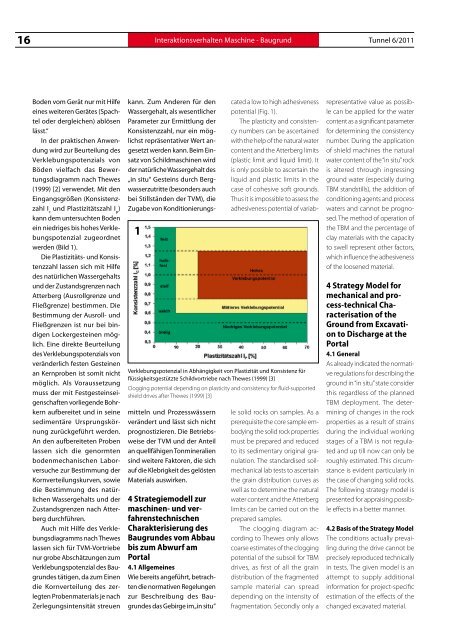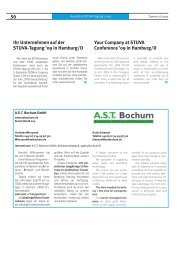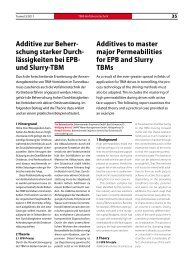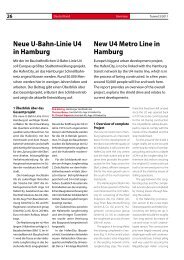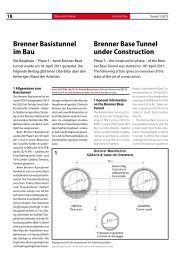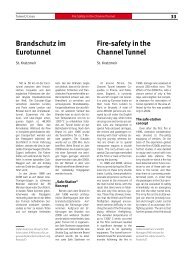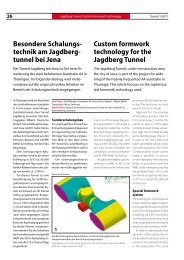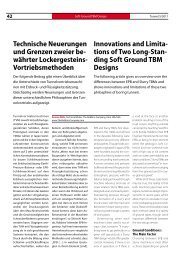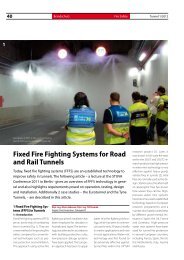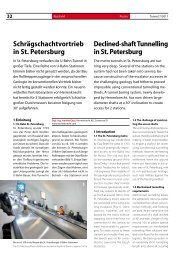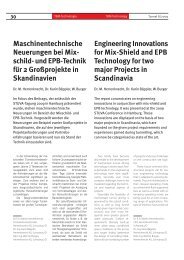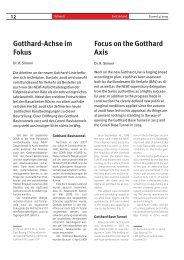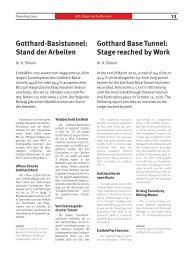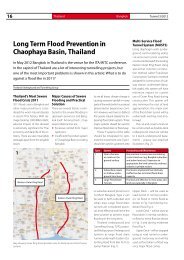Maschinen- und verfah- renstechnische Charak- terisierung ... - Tunnel
Maschinen- und verfah- renstechnische Charak- terisierung ... - Tunnel
Maschinen- und verfah- renstechnische Charak- terisierung ... - Tunnel
Erfolgreiche ePaper selbst erstellen
Machen Sie aus Ihren PDF Publikationen ein blätterbares Flipbook mit unserer einzigartigen Google optimierten e-Paper Software.
16 Interaktionsverhalten Maschine - Baugr<strong>und</strong> <strong>Tunnel</strong> 6/2011<br />
Boden vom Gerät nur mit Hilfe<br />
eines weiteren Gerätes (Spachtel<br />
oder dergleichen) ablösen<br />
lässt.“<br />
In der praktischen Anwendung<br />
wird zur Beurteilung des<br />
Verklebungspotenzials von<br />
Böden vielfach das Bewertungsdiagramm<br />
nach Thewes<br />
(1999) [2] verwendet. Mit den<br />
Eingangsgrößen (Konsistenzzahl<br />
I c<br />
<strong>und</strong> Plastizitätszahl I p<br />
)<br />
kann dem untersuchten Boden<br />
ein niedriges bis hohes Verklebungspotenzial<br />
zugeordnet<br />
werden (Bild 1).<br />
Die Plastizitäts- <strong>und</strong> Konsistenzzahl<br />
lassen sich mit Hilfe<br />
des natürlichen Wassergehalts<br />
<strong>und</strong> der Zustandsgrenzen nach<br />
Atterberg (Ausrollgrenze <strong>und</strong><br />
Fließgrenze) bestimmen. Die<br />
Bestimmung der Ausroll- <strong>und</strong><br />
Fließgrenzen ist nur bei bindigen<br />
Lockergesteinen möglich.<br />
Eine direkte Beurteilung<br />
des Verklebungspotenzials von<br />
veränderlich festen Gesteinen<br />
an Kernproben ist somit nicht<br />
möglich. Als Voraussetzung<br />
muss der mit Festgesteinseigenschaften<br />
vorliegende Bohrkern<br />
aufbereitet <strong>und</strong> in seine<br />
sedimentäre Ursprungskörnung<br />
zurückgeführt werden.<br />
An den aufbereiteten Proben<br />
lassen sich die genormten<br />
bodenmechanischen Laborversuche<br />
zur Bestimmung der<br />
Kornverteilungskurven, sowie<br />
die Bestimmung des natürlichen<br />
Wassergehalts <strong>und</strong> der<br />
Zustandsgrenzen nach Atterberg<br />
durchführen.<br />
Auch mit Hilfe des Verklebungsdiagramms<br />
nach Thewes<br />
lassen sich für TVM-Vortriebe<br />
nur grobe Abschätzungen zum<br />
Verklebungspotenzial des Baugr<strong>und</strong>es<br />
tätigen, da zum Einen<br />
die Kornverteilung des zerlegten<br />
Probenmaterials je nach<br />
Zerlegungsintensität streuen<br />
1<br />
Verklebungspotenzial in Abhängigkeit von Plastizität <strong>und</strong> Konsistenz für<br />
flüssigkeitsgestützte Schildvortriebe nach Thewes (1999) [3]<br />
Clogging potential depending on plasticity and consistency for fluid-supported<br />
shield drives after Thewes (1999) [3]<br />
mitteln <strong>und</strong> Prozesswässern<br />
verändert <strong>und</strong> lässt sich nicht<br />
prognostizieren. Die Betriebsweise<br />
der TVM <strong>und</strong> der Anteil<br />
an quellfähigen Tonmineralien<br />
sind weitere Faktoren, die sich<br />
auf die Klebrigkeit des gelösten<br />
Materials auswirken.<br />
4 Strategiemodell zur<br />
maschinen- <strong>und</strong> <strong>verfah</strong><strong>renstechnische</strong>n<br />
<strong>Charak</strong><strong>terisierung</strong> des<br />
Baugr<strong>und</strong>es vom Abbau<br />
bis zum Abwurf am<br />
Portal<br />
4.1 Allgemeines<br />
Wie bereits angeführt, betrachten<br />
die normativen Regelungen<br />
zur Beschreibung des Baugr<strong>und</strong>es<br />
das Gebirge im „in situ“<br />
le solid rocks on samples. As a<br />
prerequisite the core sample embodying<br />
the solid rock properties<br />
must be prepared and reduced<br />
to its sedimentary original granulation.<br />
The standardised soilmechanical<br />
lab tests to ascertain<br />
the grain distribution curves as<br />
well as to determine the natural<br />
water content and the Atterberg<br />
limits can be carried out on the<br />
prepared samples.<br />
The clogging diagram according<br />
to Thewes only allows<br />
coarse estimates of the clogging<br />
potential of the subsoil for TBM<br />
drives, as first of all the grain<br />
distribution of the fragmented<br />
sample material can spread<br />
depending on the intensity of<br />
fragmentation. Secondly only a<br />
kann. Zum Anderen für den<br />
Wassergehalt, als wesentlicher<br />
Parameter zur Ermittlung der<br />
Konsistenzzahl, nur ein möglichst<br />
repräsentativer Wert angesetzt<br />
werden kann. Beim Einsatz<br />
von Schildmaschinen wird<br />
der natürliche Wassergehalt des<br />
„in situ“ Gesteins durch Bergwasserzutritte<br />
(besonders auch<br />
bei Stillständen der TVM), die<br />
Zugabe von Konditionierungscated<br />
a low to high adhesiveness<br />
potential (Fig. 1).<br />
The plasticity and consistency<br />
numbers can be ascertained<br />
with the help of the natural water<br />
content and the Atterberg limits<br />
(plastic limit and liquid limit). It<br />
is only possible to ascertain the<br />
liquid and plastic limits in the<br />
case of cohesive soft gro<strong>und</strong>s.<br />
Thus it is impossible to assess the<br />
adhesiveness potential of variabrepresentative<br />
value as possible<br />
can be applied for the water<br />
content as a significant parameter<br />
for determining the consistency<br />
number. During the application<br />
of shield machines the natural<br />
water content of the “in situ” rock<br />
is altered through ingressing<br />
gro<strong>und</strong> water (especially during<br />
TBM standstills), the addition of<br />
conditioning agents and process<br />
waters and cannot be prognosed.<br />
The method of operation of<br />
the TBM and the percentage of<br />
clay materials with the capacity<br />
to swell represent other factors,<br />
which influence the adhesiveness<br />
of the loosened material.<br />
4 Strategy Model for<br />
mechanical and process-technical<br />
Characterisation<br />
of the<br />
Gro<strong>und</strong> from Excavation<br />
to Discharge at the<br />
Portal<br />
4.1 General<br />
As already indicated the normative<br />
regulations for describing the<br />
gro<strong>und</strong> in “in situ” state consider<br />
this regardless of the planned<br />
TBM deployment. The determining<br />
of changes in the rock<br />
properties as a result of strains<br />
during the individual working<br />
stages of a TBM is not regulated<br />
and up till now can only be<br />
roughly estimated. This circumstance<br />
is evident particularly in<br />
the case of changing solid rocks.<br />
The following strategy model is<br />
presented for appraising possible<br />
effects in a better manner.<br />
4.2 Basis of the Strategy Model<br />
The conditions actually prevailing<br />
during the drive cannot be<br />
precisely reproduced technically<br />
in tests. The given model is an<br />
attempt to supply additional<br />
information for project-specific<br />
estimation of the effects of the<br />
changed excavated material.


